Alum giving eighth graders chance to dream about college
Steve Hildebrand ’86 has hundreds of reasons to smile when he comes back to campus. Most of those relate to who he is with.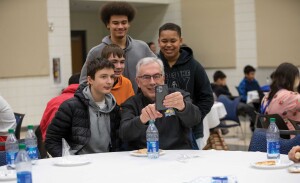
That would be hundreds of eighth graders from high-poverty middle schools in Sioux Falls who are getting a first taste of college. They are on campus through the Promising Futures Fund, a nonprofit Hildebrand created to give low-income Sioux Falls youth a better chance in life, a chance he was given when his father died.
Steve was just 5 when his dad, John Hildebrand, died in a construction accident in 1968. His father left behind a wife and nine children, of whom Steve was the youngest.
Thanks to the Mitchell community and the Catholic Church, many of the medical bills were paid and the family was able to survive. Though Hildebrand was young, the generosity marked him. He made a vow to help others when he was in a position to do so. That time came in 2019, when he decided to start the Promising Futures Fund.
“As I watched the poverty rate grow in Sioux Falls, since no one else was doing something to help the schools, I decided I would,” Hildebrand said. “We started three years ago with Lowell Elementary and focused primarily on reading, bringing books into schools to help kids become passionate readers.”
Now the program is in 13 elementary schools, three middle schools and three high schools reaching about 11,000 students.
College field trips for eighth graders
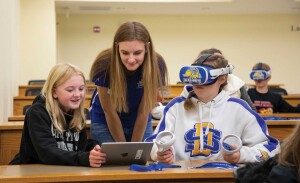 “Every eighth grader from George McGovern, Whittier and Ben Reifel will visit a college campus and a tech school before they leave the eighth grade so they have all four years of high school to plan should they want to attend a college or a technical school,” explained Hildebrand, who also works with the University of South Dakota, Augustana University, Dakota State University and Southeast Technical College.
“Every eighth grader from George McGovern, Whittier and Ben Reifel will visit a college campus and a tech school before they leave the eighth grade so they have all four years of high school to plan should they want to attend a college or a technical school,” explained Hildebrand, who also works with the University of South Dakota, Augustana University, Dakota State University and Southeast Technical College.
“It’s an opportunity to see what a college campus is all about should they take that step,” Hildebrand said.
The program hasn’t been in place long enough to test the effectiveness of the campus visits against college enrollment. However, the anecdotal evidence is powerful.
“Teachers and principals say the kids don’t stop talking about the experience. They’re inspired by the prospect of going to college. One of them said, ’I could see myself going to a place like this.’ We just want them to have that exposure and begin dreaming about that future,” said Hildebrand, who tags along on the 4 ½-hour campus visits.
Activities include witnessing chemistry wizardry, diagnosing patients in the nursing simulation lab, taking a student’s pulse and touring the dairy microbiology lab where SDSU ice cream is made.
’The mark of a successful trip?’
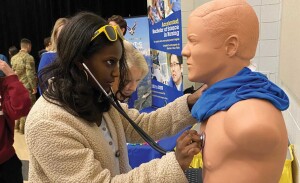 Reflecting on a fall 2022 trip to campus, Hildebrand wrote on the Promising Futures Facebook page, “The mark of a successful trip? When you hear students say out loud, ’I could see myself coming to a place like this.’
Reflecting on a fall 2022 trip to campus, Hildebrand wrote on the Promising Futures Facebook page, “The mark of a successful trip? When you hear students say out loud, ’I could see myself coming to a place like this.’
“When an eighth grader says, ’I don’t know if I can wait four whole years to go to college,’ you know she was inspired.
“One of the Whittier Middle School teachers joked that she practically had to bribe one student to come to school that day for the trip to SDSU. At the end of the day, the student said she was glad she came and that ’I’m definitely going to college.’ This student needed this experience to see what life can be … We even heard one say they plan to go to SDSU to learn to make ice cream!”
In a later interview, Hildebrand explained, “Kids in poverty oftentimes don’t get an opportunity to visit a college campus before they graduate from high school. The purpose of these trips is to provide that exposure, to give the kids a chance to be on campus themselves, to be able to explore possibilities for their future and take the chance to dream.
“We want them to be able to see all the possibilities in life and know they can do anything and be anything.”
Rubbing shoulders with players, musicians
Many eighth graders also have an opportunity to take an extracurricular trip to campus. One such trip was Oct. 8, 2022, when 160 football players attended the SDSU-USD football game and 100 members of the Ben Reifel band performed the national anthem with SDSU’s Pride of the Dakotas Marching Band.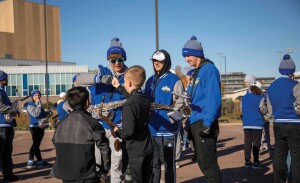
Erika Paladino-Hazlett, principal at Whittier Middle School, said, “Some of the biggest impact we have seen has been from going to the SDSU football games and USD football games and volleyball games. I know that college campuses are Steve’s huge drive, and that was an amazing experience for all of us.
“All of these things come together to provide students this vision. We always talk about how you can’t be what you can’t see. How do you even know what is out there?
“If you back that vision up and you have students who have never seen higher education or technical schools, they don’t know why they are in school. Steve providing the opportunity to connect was a huge thing for our students and then to see themselves playing on a field, playing on a court, being in a classroom.”
’I will be in that program someday’
Promising Futures’ mission dovetails smoothly with SDSU’s land-grant mission to extend the benefits of higher education to populations who traditionally have been shut out of academia, President Barry Dunn said.
Based on what Hildebrand is seeing, the seed has not only been planted, it’s starting to germinate.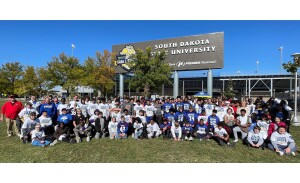
“An eighth grader from Whittier paged through the football program with the woman at the gate selling them. When they were finished, he said, ’I will be in that program someday.’”
Dave Graves






